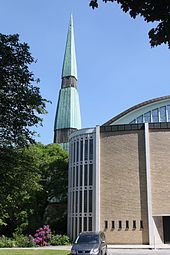St. Marien (Hamburg-Ohlsdorf)
The Evangelical Lutheran Church of St. Marien originally belonged to Hamburg-Fuhlsbüttel , after changes to the border it now belongs to Hamburg-Ohlsdorf . It is located on a corner plot of the Maienweg and Am Hasenberge streets in close proximity to the banks of the Alster .
Building the church
The church is the work of the Hamburg architects Bernhard Hopp and Rudolf Jäger from 1958 to 1960 and is rated as their "most impressive contribution to post-war modernism". It was inaugurated on February 14, 1960. The nave, tower and community buildings stand close together, only the steep, 47-meter-high tower with its idiosyncratic shape and copper roofs stands out clearly. The building is a reinforced concrete structure that was almost completely faced with yellow clinker bricks.
The church has an exceptional location directly within the public green space along the Alster, from which it and its outbuildings are not structurally separated. Despite the proximity to the water, the architects only attempted to relate the church to the river in one of their unrealized designs. Today there are some larger trees between the east facade and the Alster, so that there is no longer a view of the entire building from the waterfront.
The interior, which can accommodate 600 people, has an open design with slim round supports and a parabolic floor plan tapering towards the sanctuary. The symmetrical room combines round and straight wall elements, making it appear light and still clearly focused on the altar area. As is typical of the time, the parish and choir are combined into one unit. The interior receives daylight through covered windows in the chancel and a light band under the ceiling, which is wider on the entrance wall than on the long sides. Additional lighting accents are set by twelve small glass windows in the choir wall, which Charles Crodel created according to his own proposal.
Furnishing
All principal pieces and the altar candlesticks are designs by Jürgen Weber , which he implemented around 1960. The bronze altar crucifix is the most notable of these elements. On one of the pulpit reliefs , Schröder depicted the destruction of Sodom and Gomorrah with a very clear analogy to the Hamburg firestorm of 1943. The communion implements come from Ragna Sperschneider .
Four bronze bells from the Rincker foundry hang in the tower .
organ
Alfred Führer designed the organ back in 1962 as a typical North German baroque organ. From 2011 to 2012 a restoration was carried out by Orgelbau Bente , during which three registers were added.
The disposition is for the restoration:
|
|
|
||||||||||||||||||||||||||||||||||||||||||||||||||||||||||||||||||||||||||||||
- Coupling : II / I, I / P, II / P
Remarks
Photographs and map
Coordinates: 53 ° 37 ′ 20 ″ N , 10 ° 1 ′ 37 ″ E
literature
- Ralf Lange : Architecture in Hamburg . Junius Verlag , Hamburg 2008, ISBN 978-3-88506-586-9 , p. 239 .
- Gertrud Schiller : Hamburg's new churches 1951–1961 . Ed .: Evangelical Lutheran Church Hamburg. Hans Christians Verlag, Hamburg 1961, p. 38-41, 78 .
- Hans-Georg Soeffner , Hans Christian Knuth, Cornelius Nissle: Roofs of Hope, church building in Hamburg between 1950 and 1970 . Christians Verlag, Hamburg 1995, ISBN 3-7672-1245-5 , p. 129-131 .
Individual evidence
- ↑ Hans-Georg Soeffner, Hans Christian Knuth, Cornelius Nissle: Roofs of Hope, church building in Hamburg between 1950 and 1970 . Christians Verlag, Hamburg 1995, ISBN 3-7672-1245-5 , p. 129 .
- ↑ Disposition of the Führer organ from 1962 in the organ database orgbase.nl . Retrieved February 9, 2017.
- ↑ Entry on the Bente homepage. Retrieved February 8, 2017.
Web links
- Homepage of the community
- Description of the renovation of the organ on the municipality's website.





